
Ninf: A Network based Information Library for
Global World-Wide Computing Infrastructure
Ninf is an ongoing global network-wide computing infrastructure
project which allows users to access computational resources including
hardware, software and scientific data distributed across a wide area
network with an easy-to-use interface. Ninf is intended not only to
exploit high performance in network parallel computing, but also to
provide high quality numerical computation services and accesses to
scientific database published by other researchers.
Computational resources are shared as Ninf remote
libraries executable at a remote Ninf server. Users can build an
application by calling the libraries with the Ninf Remote Procedure
Call, which is designed to provide a programming interface
similar to conventional function calls in existing languages, and is
tailored for scientific computation. In order to facilitate location
transparency and network-wide parallelism, Ninf
metaserver maintains global resource information regarding
computational server and databases, allocating and scheduling
coarse-grained computation to achieve good global load balancing.
Ninf also interfaces with existing network service such as the WWW for easy
accessibility.
Remarkable growth of computer network technology has spurned a variety of
information services accessible through the Internet. The important
feature of such services is location transparency; information can be
obtained irrespective of time or location in a virtually shared manner.
However, most existing global network services such as e-mail, file
archives, and the WWW, are limited to merely sharing data resources. The
global network could be far better utilized, embodying the potential to
provide a computational environment to share computational resources
including CPUs and disk storage. The coming of gigabit information
superhighway will further enhance the vision of world-wide global
computing resources, being able to tap into powers of enormous numbers of
computers with idle computation cycles.
As an infrastructure for world-wide global computing in scientific
computation, we are currently pursuing the Ninf
(Network based Information Library for high
performance computing) project [1]. Our
goal is to provide a platform for global scientific computing with
computational resources distributed in a world-wide global network.
The paper describes the motivation of Ninf, its components,
and the underlying technologies that support such global computing.
The basic Ninf system supports client-server based computing. The
computational resources are available as remote libraries at a remote
computation host which can be called through the global network from a
programmer's client program written in existing languages such as Fortran,
C, or C++. The parameters, including large arrays, are efficiently marshalled
and sent to the Ninf server on a remote host, which in turn
executes the requested libraries, and sends back the result. The Ninf
remote procedure call (RPC) is designed to provide programming
interface which will be very familiar to the programmers of existing
languages. The programmer can build a global computing systems by using
the Ninf remote libraries as its components, without being aware of
complexities and hassles of network programming.
The benefits of Ninf are as follows:
-
A client can execute the most time-consuming part of his program in
multiple, remote high-performance computers, such as vector supercomputers
and MPPs, without any requirement for special hardware or operating
systems. If such supercomputers are reachable via a high speed network,
the application will naturally run considerably faster.
It also provides uniform access to a variety of supercomputers.
- The Ninf programming interface is designed to be extremely
easy-to-use and familiar-looking for programmers of existing languages
such as FORTRAN, C and C++. The user can call the remote libraries without
any knowledge of the network programming, and easily convert his existing
applications that already use popular numerical libraries such as LAPACK.
Servers can be specified in a variety of ways, including environment
variables, URLs, startup files, etc. This is one of the philosophy of Ninf
design, i.e. "Make the interface as transparent and flexible as possible
to use."
- The Ninf RPC can also be asynchronous and automatic: for parallel
applications, a group of Ninf metaservers maintains the
information of Ninf servers in the network in a distributed manner, and
automatically allocates remote library calls dynamically on appropriate
servers for load balancing. To allocate multiple calls to achieve
network-wide parallelism, Ninf provides a transaction system, where the
data-dependencies among the Ninf calls are automatically detected and
scheduled by the metaserver. The Ninf metaserver could be regarded as a
network agent which locates an appropriate server depending on client
request and status of network resources.
- The Ninf network database server provides query on accurate constant
database needed in scientific computation, such as important constants of
physics and chemistry. By doing so, the user is freed from the burdens
and mistakes of inputting accurate constant data from printed charts.
Furthermore, we plan to develop a framework where data values of reports
on experiments by researchers could be referenced directly over a network
in the midst of user's computation. Such provisions for attaining
accuracy is especially important for natural science areas such as
experimental physics, astronomy, chemistry, medicine, and biology, etc.
While Ninf can serve to speed-up the applications by exploiting the power
of remote supercomputer servers and network parallelism, it is a convenient
tool for obtaining the answer of a particular numerical function and
values quickly. We have designed a WWW interface as a front-end so that
Ninf libraries registered in computation servers could be cataloged,
browsed, and tried out through Web browsers.
From the user's perspective, Ninf offers yet another way to share
resources over a global network. On the other hand, there are already
various network infrastructures and tools already in use, and one might ask
would another infrastructure be needed; for example, one could claim the
extreme that, one could use existing file transfer services such as ftp
to remotely obtain numerical libraries, compile on his local machine, and
execute the program there. Aside from the issue of having a supercomputer
locally on hand, there are many other advantages to Ninf in this case ---
security and proprietary issues naturally are obvious topics; there are
other practical issues of expending the efforts of fetching, compiling, and
maintaining code in heterogeneous computing environments. Ninf allows
reduction of maintenance costs by concentrating the efforts of
high-quality, well-maintained libraries on compute servers and not on each
machine. Thus, even for slower networks where there are no speed
advantages to be gained, Ninf is still beneficial in this regard.
The rest of the paper gives an overview of the entire Ninf system, its
interface, and its underlying technologies. Section 2 gives
an overview of Ninf and reports a preliminary result;
Section 3 describes the Ninf metaserver and its parallel programming.
In Section 4, presents some applications of Ninf.
Related Work is briefly discussed in Section 5.
We finally presents the current status and future work in Section 6.
The basic Ninf system employs a client-server model. The server machine
and a client may be connected via a local area network or over an
Internet. Machines may be heterogeneous: data in communication
is translated into the common network data format.
A Ninf server process runs on the Ninf computation server host. The Ninf
remote libraries are implemented as executable programs which contain
network stub routine as its main routine, and managed by the
server process. We call such executable programs Ninf executables
(programs) . When the library is called by a client program, the Ninf
server searches the Ninf executables associated with its name, and
executes the found executable, setting up an appropriate communication
with the client. The stub routine handles the communication to the Ninf
server and its client, including argument marshaling. The underlying
executable can be written in any existing scientific languages such as
Fortran, C, etc., as long as it can be executed in the host.
A library provider , who provides the numerical library and
computational resource to the network at large, prepares the Ninf
executables by
(1) writing the necessary interface description of each
library function in Ninf IDL (Interface Description Language) ,
(2) running the Ninf IDL compiler, which emits the necessary header files
and stub code,
(3) Compiling the library with the compiler for the
programming language the library is written in,
and, (4) linking with the Ninf RPC libraries,
finally, (5) registering them with the
Ninf server running on his host.
After these steps, anyone in the network
can use the libraries by the Ninf RPC in a transparent. Some existing
libraries, such as LAPACK, have already been 'Ninfied' in this manner.
The Ninf user interface consists of programming and browsing interfaces.
The client user can call the Ninf library directly from his program, or
experiment with the library interactively using the Ninf browsing tool on
the WWW. As we will see later on, the Ninf client interface is remarkably
simple; the user merely needs to link the Ninf_call() routine
which acts as the sole interface to all functionalities provided by Ninf.
Thus, on the client side, the user merely needs to download and link a
small, precompiled Ninf client library, without ever experiencing the
hassles of maintaining the latest source code, header files, IDL files,
and their associated makefiles.
Also, the browsing tool helps the user to find required
functions from available sever in the network.
Such a design has been motivated by the desire to provide a
simplest, language-independent client interface to the Ninf
infrastructure, while relieving the users of code/library maintenance.
In the current implementation, the communication between a client and the
server is achieved by means of standard TCP/IP connection to ensure
reliable communication between processes. In an heterogeneous environment,
Ninf uses the Sun XDR data format as a default protocol.
Also, as we shall see, clients can
also specify call back functions on the client side for various purposes,
such as interactive data visualization, I/O of data, etc.
As mentioned above, Ninf_call() is the sole client interface to
the Ninf compute and database servers. In order to illustrate the
programming interface with an example, let us consider a simple matrix
multiply routine in C programs with the following interface:
double A[N][N],B[N][N],C[N][N]; /* declaration */
....
dmmul(N,A,B,C); /* calls matrix multiply, C = A * B */
When the dmmul routine is available on a Ninf server,
the client program can call the remote library using Ninf_call ,
in the following manner:
Ninf_call("dmmul",N,A,B,C); /* call remote Ninf library on server */
Here, dmmul is the name of library registered as a Ninf
executable on a server, and N,A,B,C are the same arguments.
As we see here, the client user only needs to specify the name
of the function as if he were making a local function call;
Ninf_call() automatically determines the function arity and
the type of each argument, appropriately marshals the arguments, makes
the remote call to the server, obtains the results, places the
results in the appropriate argument, and returns to the client.
In this way, the Ninf RPC is designed to give the users an
illusion that arguments are shared between the client and the server.
The reader may also notice that the physical location of the Ninf server
is not specified in the example. Ninf provides a variety of ways for
the client to specify the server and its registered library:
- Specify server with a .ninfrc file.
- Specify server with an environment variable.
- Directly specify server and library with an URL of the Ninf executable.
- Automatic server allocation by Ninf metaserver.
To realize such simplicity in the client programming interface,
we designed Ninf RPC so that client function call obtains all the
interface information regarding the called library function at runtime
from the server. Although this will cost an extra network round trip
time, we judged that typical scientific applications are both
compute and data intensive such that the overhead should be small
enough. The interface information includes:
- the number of parameters.
- argument types.
- access mode of arguments (read or write).
- size of arguments.
- argument marshaling information.
- how to send and receive data from/to the Ninf server.
As shown in Figure 1, the client function call requests the interface
information of the calling function to the Ninf server, which in turn
returns the registered Ninf executable interface information to the client.
The client library then interprets and marshals the arguments on the
stack according to the supplied information. For variable-sized array
arguments, the IDL must specify an expression that includes the input
scalar arguments whereby the size of the arrays can be computed.
This design is in contrast to traditional RPCs, where stub generation
is done on the client side at compile time. As a result of dynamic
interface acquisition, Ninf RPC does not require such compile-time
activities at all, relieving the users from any code maintenance.
[2] describes the structure of the
interface information and the protocol in detail.
In the above example, the client function call sends the input arrays,
A and B,
whose size is computed by the parameter N .
The Ninf server invokes the Ninf executable of dmmul library,
and forwards the input data to it.
When the computation is done, the result is sent back to the client
through the server. The client function call stores the returned data at
the location pointed by the argument, C.
The Ninf RPC may also be invoked asynchronously to exploit network-wide
parallelism. It is possible to issue the request to a Ninf server,
continue with the other computation, and poll for the request later.
Multiple RPC requests to different servers are also possible. For this
reason, the asynchronous Ninf PRC is an important feature for parallel
programming, as we describe in Section 3.
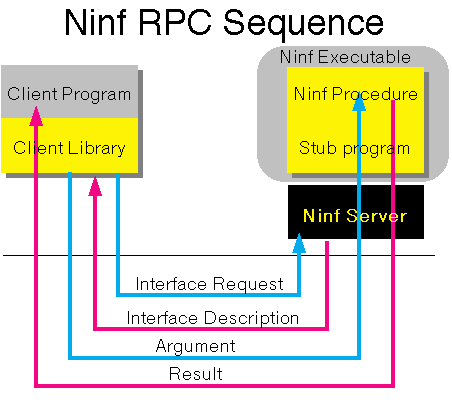
Figure 1: Ninf RPC
The Ninf library provider describes the interface of the library
function in Ninf IDL to register his library function into the Ninf server.
Since the Ninf system is designed for numerical applications, the
supported data type in Ninf is tailored for such a purpose; for example,
the data types are limited to scalars and their multi-dimensional arrays.
On the other hand, there are special provisions in the IDL for numerical
applications, such as support for
expressions involving input arguments to compute array size, designation
of temporary array arguments that need to be allocated on the server side
but not transferred, etc.
For example, the interface description for the matrix multiply
given in the previous section is:
Define dmmul(long mode_in int n, mode_in double A[n][n],
mode_in double B[n][n], mode_out double C[n][n])
"... description ..."
Required "libxxx.o" /* specify library including this routine. */
Calls "C" dmmul(n,A,B,C); /* Use C calling convention. */
where the access specifiers ,
mode_in and mode_out , specify
whether the argument is read or written.
To specify the size of each argument, the other mode_in arguments
can be used to form a size expression.
In this example, the value of n is
referenced to calculate the size of the array arguments A, B, C .
In addition to the interface definition of the library function,
the following information has to be described in the IDL:
- the library function to be registered,
- a module name to specify the library name,
- the language, in which the library is programmed,
- linking options to create the executables.
- aliases (names) for the library function.
As illustrated in Figure 2, the interface description is compiled by the
Ninf interface generator to generate a stub program for each
library function described in its interface information. The interface
generator also automatically outputs a makefile with which the Ninf
executables can be created by linking the stub programs and library functions.
The interface description can also include the textual information, which
is used to automatically create manual pages for the library functions.
The remote users can browse the available library functions in the
server, its interface, and the other information generated by the
interface generator through a Web browser interface.
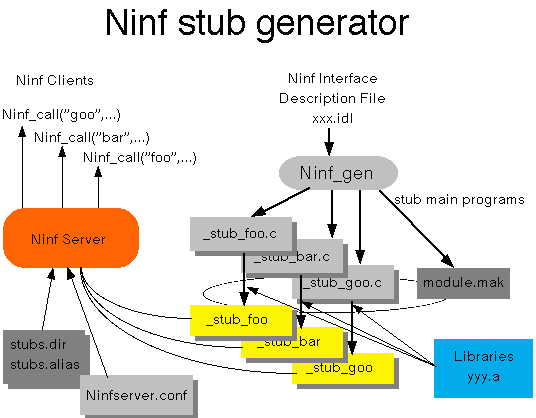
Figure 2: Ninf IDL and interface generator
Since the Ninf client programming interface is designed to be as
language independent as possible, the Ninf client may written
in a variety of programming languages.
It is usually easy to design a client interface to Ninf, so long as
the language supports standard foreign function interface to C programs.
We have already designed and implemented the client
Ninf_call functions
for C, FORTRAN, Java, and Lisp. The client and the remote library
can be written in a totally different language.
One caveat is that the language must support variable number arguments,
which must be properly converted to multiple arguments being pushed onto
the stack for foreign C function calls. Otherwise, the
arguments must be passed in an array, and a glue code must be inserted to
perform the necessary marshaling from the array.
The interface information may also be used on the client side at compile
time. The remote user can get the interface information from the server
to generate appropriate client stub routine and its prototype header files
for its library which is registered there.
In this case, the program will be entirely typechecked,
improving code reliability. Also,
dynamic interface information acquisition will be skipped as mentioned
earlier, improving performance slightly. On the
other hand, instead of using only Ninf_call() , the user must
call the client stub routine that will be created for each function
available at the server.
Figure 3 shows preliminary performance of Linpack benchmark
with the Ninf.
We use a SUN SparcStation-20 (40 MHz SuperSPARC, 131MB memory) as a client.
The Ninf server runs at JCC Ultra Sparc JU1/140 (143 MHz UltraSPARC,
98 MB memory).
These machines are connected by a 100 base-TX ether switch.
The performance of the client local computation is
from 1.1 MFLOPS to 0.9 MFLOPS as indicated
in the dashed line, and
the performance of the host is from 2.5 MFLOPS to 1.8 MFLOPS
2.
In the Ninf program of Linpack,
two routines, dgefa and dgesl ,
are called as the remote Ninf libraries in the Ninf server.
The solid line indicates the performance using the Ninf call.
Note that the Ninf program's performance exceeds the local performance
when the matrix size is larger than 800.
For the matrix size n ,
the computation time is O(n3) and
the data transfer time is O(n2) .
As the matrix size is increased, the Ninf program can take more advantage
of the high performance remote machine.
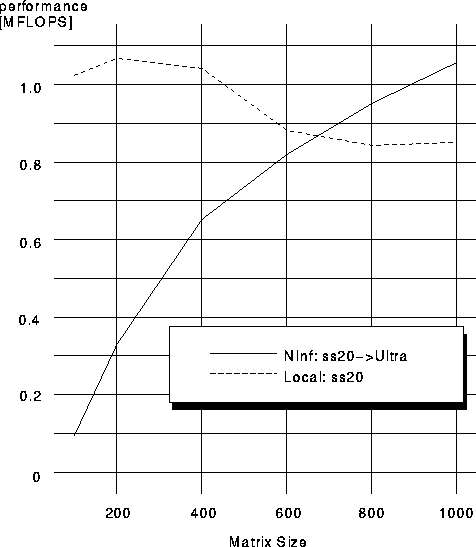
Figure 3: Ninf Performance for Linpack benchmark
The Ninf metaserver [3] is
an agent, a set of which gathers network information regarding the
Ninf servers, and also helps the client to choose an appropriate Ninf
server, either automatically or semi-automatically.
When the client executes in Ninf transaction mode,
he is able to issue a request to a metaserver, who in turn
chooses the appropriate server and delegates the request.
Also, instead of calling the server directly, the user may
call the metaserver directly to find
the "best" server to execute the requested library,
resulting in good load balancing for multiple severs over the entire
network.
The current metaserver is implemented in Java, in order
to exploit its portability, ease of network programming, and
multi-threading, and also given that speed is not an absolute factor.
When the number of Ninf servers are increased, it becomes increasingly
difficult for a client to determine which server he should select
among the ones in the network. The Ninf metaserver helps to alleviate
this situation by gathering the meta-information of the status and the
resource made available by the servers, and also by making Ninf
services location transparent. For example, if many clients share the
same server, the computation time is greatly influenced by the
computation requested by other clients. Such dynamic information is
constantly probed and delegated to other metaservers in a distributed
way. To be more specific, the Ninf metaserver keeps track of the
following information for each Ninf server:
- the location (address and port number).
- the list of functions registered in the server.
- the distance to the server with respect to the bandwidth
of communication.
- computational ability of the machine (clock speed, FLOPS, etc...)
- the status of the server including the load average.
The entire Ninf infrastructure consists of sets of servers and
metaservers distributed in a network.
Metaservers exchange information with each others periodically
For example, if a new Ninf server is added into the metaserver,
the location of the new server is propagated among the metaserver network.
Also, when a metaserver does not have a particular information available
(e.g., availability of a certain library), a query is propagated through
the metaserver network and the result is gathered by the issuing
metaserver, who in turn delegates the info or makes automatic
decisions for the client (Figure 4).
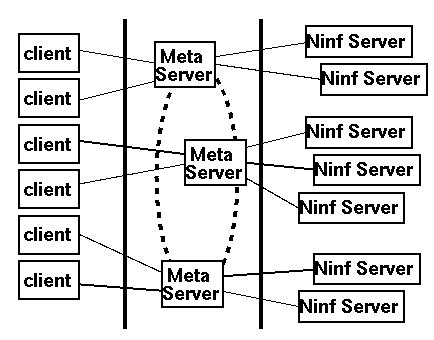
Figure 4: Ninf metaserver network
Load balancing is one of the most important features of the Ninf metaserver.
The metaserver is able to find the "best" server
with respect to the computational ability and the current load status.
In addition, in order to support parallel programming,
the client issues multiple requests asynchronously via a Ninf
call Ninf_call_async() .
Each outstanding request is dispatched to the
best server by the metaserver.
The client may continue its local computation, and wait
for result to come back with Ninf_call_wait function.
Another programming interface for parallel programming
Ninf parallel transaction, as mentioned earlier.
The parallel transaction is a program region surrounded by
Ninf_check_in() and Ninf_check_out() .
When Ninf_check_in() is executed,
the Ninf calls do not issue actual requests spontaneously,
but the information of the calls are is stored
and a dataflow graph is built to represent the data dependency
of the remote computations. When the execution reaches
Ninf_check_out() , the dataflow graph is sent to the Ninf
metaserver. The metaserver schedules the computations
in the dataflow graph to execute them efficiently with multiple Ninf
servers, according to the information it has. For example,
Ninf_check_in();
Ninf_call("dmmul",N,A,B,E);
Ninf_call("dmmul",N,C,D,F);
Ninf_call("dmmul",N,E,F,G);
Ninf_check_out();
Here, the computations for E and F can be executed in
parallel. Note that the interface information of dmmul is
used to construct the dataflow graph of these computations.
At the point where Ninf_check_out() is returned,
all computations are finished.
The advantage of the parallel transaction is that the user only
inserts Ninf_check_in() and Ninf_check_out()
without modifying the sequence of the Ninf calls.
In this section, we describe some applications of the Ninf.
Consider a scientific simulation as an application of the Ninf.
A typical simulation program initializes the state,
and updates the state to display or records it at every certain time steps.
One of problems in Ninf RPC for this kind of applications is that
no client state can be maintained in a Ninf server.
When the execution of the Ninf executable is over, any information
disappears in the server. As a result, a large amount of state
must be transfered back at every call.
To alleviate this situation, Ninf supports callback
functional argument to communicate with the client regarding the
current execution state.
A Ninf library routine can take the functional argument to
call the user-supplied routine from the Ninf executable.
For simulation applications, this feature can be exploited to
implement client-side real-time visualization. The main part of
the simulation program can be supplied as a Ninf library,
and the user can set his
visualization routine to be the callback function to display the results
at each time step.
The client and the Ninf executable effectively execute as coroutines.
Figure 5 shows a typical configuration of the system. We have currently
implemented a run-time visualizer for Berkeley MP3D benchmark as
an example,
and are investigating applications to more elaborate simulations.
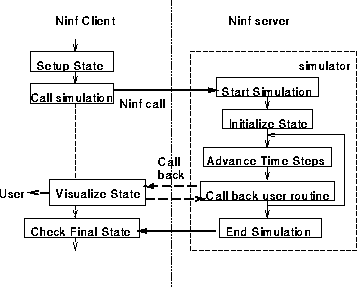
Figure 5: Call back example
The domain decomposition solver is one of the most suitable
parallel applications
for the Ninf system. In the domain decomposition method,
a large problem can be divided into several small sub-problems
which can be solved in parallel.
The master process summarizes the results of sub-problems and adjusts
the boundary conditions between the domains of sub-problems
to obtain the entire solution.
While the Ninf client performs the master process,
the solvers for sub-problems are executed
in parallel by multiple Ninf servers.
The Ninf metaserver performs load balancing
by allocating the solver's tasks to the severs
in order to minimize the entire computation time.
Interactive interfaces is often very attractive for real-world
applications.
A simple WWW-based interactive interface is provided as a part of the Ninf
browser. The user can test a library function with particular arguments
via the browser's graphical interface.
It would be also very useful to use the Ninf along with interactive languages such as
Mathematica and MATLAB [4] .
In such a system, it is usually difficult to incorporate a new
numerical function. Once a Ninf call interface is built into the
system, one can use any library functions over the network interactively.
We are currently planning to add client-side interface to Mathematica.
The high-speed global network makes possible the realization of
high performance world-wide global computing.
A few systems are proposed for such computing system:
Legion [5]
is a project for constructing the nationwide virtual computer
comprised of many supercomputers and workstations.
Legion uses an object-oriented language, Mentat [6] ,
to program global distributed computing systems.
The current version of Ninf does not allow a user to
export his program into the server.
In this sense, the Ninf is not a programming language for distributed
computing, but rather a more loosely-coupled server-client RPC-based
system with lower-threshold for people to use.
Ninf remote libraries are installed and registered in the host
only by a responsible library provider.
The client only uses them as a component for his global computing, in
a very similar manner as his local computation.
NetSolve [7] is a similar project to our Ninf project.
It also provides a easy-to-use programming interface similar to
ours, but it has no description language for interface information.
An agent process is provided for load balancing in the system,
in a similar manner as the Ninf metaserver.
The Remote Computation System (RCS) [8]
is a remote procedure call facility
to provide uniform access to a variety of supercomputers.
It focuses on load-balancing. The RCS server in the local computer
chooses solvers of remote computers.
The client must use a specific client library function to
call the associated remote library.
The prototype system is implemented on top of PVM.
As the Ninf project is an on-going effort, we do expect various
changes and extensions to occur as we gain more experience from
real applications, and as the system becomes more mature through
widespread use.
Currently, we are preparing a suite of Ninf servers on Cray J-90,
Sun UltraSparcs, and a 64-processor SparcStation 20-based NOW
cluster at Electorotechnical Laboratory of Tsukuba, Japan for
public release. On these servers, we have
ported existing mathematical libraries by defined Ninf IDLs
and registering with the Ninf server. The libraries
include linear algebra packages such as LAPACK, Cray's LibSci,
and other special mathematical libraries.
A scientific constant database for physics and
chemistry is also being designed and being built.
The database will have flexible query facilities to cope
with physical constants that change minutely over time.
Since our objective is for Ninf to be a global service infrastructure
available for free for a wide variety of scientific and engineering use,
involving not only high performance but also quality-of-use, there are still
numerous research issues to be addressed:
- Authentication and accounting:
Although Ninf itself will be available
for free, institutions will naturally want to establish its own
authentication and accounting policies. This immediately brings up a
lot of technical challenges, including local policy enforcing mechanisms
such as how one would allocate certain percentage of the machine's
capabilities to anonymous users under existing operating systems, and
global policies such as enforcing reciprocal accounting on use vs. making
computer servers available. This further transcends into protection
policies for database servers, and metaservers which must take into
account various institutional policies when scheduling the computations
automatically.
- Exporting of client code:
The current Ninf has no facilities to
execute client's code on a remote host. In some cases, it will be
desirable to export client's code for efficiency reasons --- for example, a
Ninf function implementing an iterative solve could be parameterized by an
error function for specifying termination conditions; it could then be
prohibitive to perform callback per every iteration of the solver.
Although code shipping technology is already available for interpreted
languages such as Java or Telescript, for efficiency reasons it is
desirable for the client code to be compiled using some form
of dynamic compilation techniques, while maintaining portability
and security.
- Fault tolerance:
Since global network is not fault-safe,
checkpoinging and recovery facility will be needed for fault tolerance.
We are currently planning to extend the Ninf transaction facilities into
full-fledged recoverable transactions; however, doing so without
sacrificing computation speed or wasting too much resources is not an easy
issue.
- Security: Security is naturally important, especially since
each Ninf server will act as computation server and not mere database
server. Provisions for entrusted Ninf server nodes, as well as encryption,
will be an important issue for future evolution of Ninf.
These and other issues will be developed in accordance with advancements
in other global networking standards, and other efforts on global network
computing.
References
- [1]
-
S. Sekiguchi, M. Sato, H. Nakada, S. Matsuoka and U. Nagashima,
"--- Ninf --- : Network based Information Library for Globally High
Performance Computing", Proc. of Parallel Object-Oriented Methods
and Applications (POOMA), Santa Fe, Feb., 1996.
- [2]
-
Nakada, Sato and Sekiguchi: "Ninf RPC Protocol",
ETL Technical Report TR 95-28, Electrotechnical Laboratory (1995).
- [3]
-
Nakada, Kusano, Matsuoka, Sato, Sekiguchi,
"A Metaserver Architecture for Ninf: Networked Information
Library for High Performance Computing",
IPSJ 96-HPC-60 (1996) (in Japanese).
- [4]
-
The Math Works, Inc, "MATLAB Reference Guide", 1992.
- [5]
-
A. S. Grimshaw, W. A. Wulf, J. C. French, A. C. Weaver and
P. F. Reynolds Jr,"Legion: The Next Logical Step Toward a
Nationalwide Virtual Computer", Technical Report No. CS-94-21,
University of Virginia, 1994.
- [6]
-
Grimshaw, A. S.: "Easy to Use Object-Oriented Parallel Programming with
Mentat", IEEE Computer, pp. 39--51 (1993).
- [7]
-
H. Casanova and J. Dongarra: "NetSolve: A Network Server
for Solving Computational Science Problems",
Technical Report of University of Tennessee, 1996.
- [8]
-
P. Arbenz, W. Gander and M. Oettli,
"The Remote Computational System",
Lecture Note in Computer Science, Vol. 1067,
High-Performance Computation and Network, Springer, 662-667(1996)






